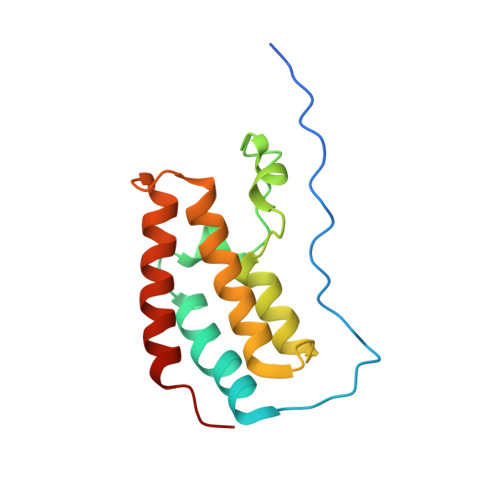Discovery of Benzo[cd]indol-2(1H)-ones as Potent and Specific BET Bromodomain Inhibitors: Structure-Based Virtual Screening, Optimization, and Biological Evaluation
Xue, X., Zhang, Y., Liu, Z., Song, M., Xing, Y., Xiang, Q., Wang, Z., Tu, Z., Zhou, Y., Ding, K., Xu, Y.(2016) J Med Chem 59: 1565-1579
- PubMed: 26731490
- DOI: https://doi.org/10.1021/acs.jmedchem.5b01511
- Primary Citation of Related Structures:
5COI, 5CP5, 5CPE, 5CQT, 5CRM, 5CRZ, 5CS8, 5CTL, 5CY9, 5D0C, 5DX4 - PubMed Abstract:
The discovery of inhibitors of bromodomain and extra terminal domain (BET) has achieved great progress, and at least seven inhibitors have progressed into clinical trials for the treatment of cancer or inflammatory diseases. Here, we describe the identification, optimization, and evaluation of benzo[cd]indol-2(1H)-one containing compounds as a new class of BET bromodomain inhibitors, starting from structure-based virtual screening (SBVS). Through structure-based optimization, potent compounds were obtained with significantly improved activity. The two most potent compounds bind to the BRD4 bromodomain, with Kd values of 124 and 137 nM. Selected compounds exhibited high selectivity over other non-BET subfamily members. Notably, compound 85 demonstrated a reasonable antiproliferation effect on MV4;11 leukemia cells and exhibited a good pharmacokinetic profile with high oral bioavailability (75.8%) and moderate half-life (T1/2 = 3.95 h). The resulting lead molecule 85 represents a new, potent, and selective class of BET bromodomain inhibitors for the development of therapeutics to treat cancer and inflammatory diseases.
Organizational Affiliation:
Institute of Chemical Biology, Guangzhou Institutes of Biomedicine and Health, Chinese Academy of Sciences , No. 190 Kaiyuan Avenue, Guangzhou Science Park, Guangzhou, Guangdong 510530, China.

















